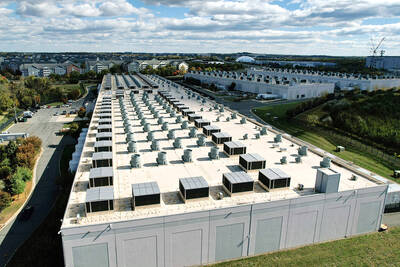What is a bitcoin worth? Lately nobody knows for sure, but after a wild ride on Friday, it is worth a good deal less than it was on Thursday.
After losses over the past few days, the digital currency fell as much as 30 percent overnight in Asia and the action became so frenzied that the Web site Coinbase suspended trading.
It later made up much of that ground and slumped 9.5 percent to US$14,042 on Friday, according to the tracking site CoinDesk.
Experts say that bitcoin is a bubble about to burst, but things might get crazier before it does: A lot of people have heard of bitcoin by now, but very few people own it.
“Bubbles burst when the last buyers are in,” First Franklin Financial Corp chief market strategist Brett Ewing said. “Who are the last buyers? The general public, unfortunately.”
Ewing said that 40 percent of bitcoin belongs to just 1,000 people and hedge funds and other major investors are going to start buying it soon, but those funds might buy bitcoin and also protect themselves by placing bets that it will fall. Retail investors might just buy it only to see it fall.
“I think investors should approach it with caution and I think many people will dive into it not understanding what it is,” he said.
As bitcoin skyrocketed this month, the volume of trading was unprecedented as investors hoping to catch a ride up piled in. Prices have risen so fast that on Friday, it returned to where it was trading only two weeks ago.
Bitcoin is still difficult to use to actually buy something. The currency has been highly elastic, bouncing back every time it crashes, which occurs about once every quarter. It fell 11.5 percent over two days early this month and 21.5 percent over five days last month.
Curiosity has now driven bitcoin to the futures market, where investors bet on which direction it will go.
Bitcoin futures started trading on two major exchanges — the Cboe Global Markets Inc and CME Group Inc — this month. Those futures fell about 8 percent on Friday.
Michael Novogratz, the former macro manager who has turned into one of the biggest champions of bitcoin, shelved plans to start a cryptocurrency hedge fund and predicted that the digital money might extend its plunge to US$8,000.
“We didn’t like market conditions and we wanted to re-evaluate what we’re doing,” Novogratz said on Friday in a telephone interview. “I look pretty smart pressing the pause button right now.”
Novogratz said he told potential investors last week that he changed his mind, two days before his Galaxy Digital Assets Fund was due to start on Dec. 15.
He cited a growing number of hurdles, including the prospect of buying bitcoin or ether for his clients, while simultaneously selling crypto investments in his personal account.
However, Novogratz, who previously called cryptocurrencies the “biggest bubble of our lifetimes,” is not giving up on them and said he still believes they will be a disruptive force in finance.
Novogratz said that it would take the market a while to recover and bitcoin prices would probably consolidate between US$10,000 and US$16,000 — and would not approach US$20,000 again for at least three to four months.
“When you get kicked this hard, it takes a lot of ice to get the swelling down,” he said.
Additional reporting by Bloomberg

The demise of the coal industry left the US’ Appalachian region in tatters, with lost jobs, spoiled water and countless kilometers of abandoned underground mines. Now entrepreneurs are eyeing the rural region with ambitious visions to rebuild its economy by converting old mines into solar power systems and data centers that could help fuel the increasing power demands of the artificial intelligence (AI) boom. One such project is underway by a non-profit team calling itself Energy DELTA (Discovery, Education, Learning and Technology Accelerator) Lab, which is looking to develop energy sources on about 26,305 hectares of old coal land in

Taiwan’s exports soared 56 percent year-on-year to an all-time high of US$64.05 billion last month, propelled by surging global demand for artificial intelligence (AI), high-performance computing and cloud service infrastructure, the Ministry of Finance said yesterday. Department of Statistics Director-General Beatrice Tsai (蔡美娜) called the figure an unexpected upside surprise, citing a wave of technology orders from overseas customers alongside the usual year-end shopping season for technology products. Growth is likely to remain strong this month, she said, projecting a 40 percent to 45 percent expansion on an annual basis. The outperformance could prompt the Directorate-General of Budget, Accounting and

Netflix on Friday faced fierce criticism over its blockbuster deal to acquire Warner Bros Discovery. The streaming giant is already viewed as a pariah in some Hollywood circles, largely due to its reluctance to release content in theaters and its disruption of traditional industry practices. As Netflix emerged as the likely winning bidder for Warner Bros — the studio behind Casablanca, the Harry Potter movies and Friends — Hollywood’s elite launched an aggressive campaign against the acquisition. Titanic director James Cameron called the buyout a “disaster,” while a group of prominent producers are lobbying US Congress to oppose the deal,

Two Chinese chipmakers are attracting strong retail investor demand, buoyed by industry peer Moore Threads Technology Co’s (摩爾線程) stellar debut. The retail portion of MetaX Integrated Circuits (Shanghai) Co’s (上海沐曦) upcoming initial public offering (IPO) was 2,986 times oversubscribed on Friday, according to a filing. Meanwhile, Beijing Onmicro Electronics Co (北京昂瑞微), which makes radio frequency chips, was 2,899 times oversubscribed on Friday, its filing showed. The bids coincided with Moore Threads’ trading debut, which surged 425 percent on Friday after raising 8 billion yuan (US$1.13 billion) on bets that the company could emerge as a viable local competitor to Nvidia